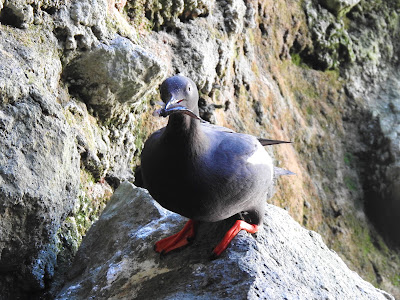After all of my family had gotten over our jetlag, we officially started our journey. Our first stop was Florence, Oregon.We went on a total of three very memorable birding trips.
 |
| Pigeon Guillemot, the fish in its mouth is for its young |
The first spot was a place called Sea Lion Caves, a privately-owned tourist attraction since 1932! To get down to the actual caves you have to take an elevator and go down 10 stories.The caves are really dark, there is also a mesh wire between you and the wildlife. Even though it was dark, you can still hear the yelps of Pigeon Guillemots, and the occasional black silhouette flashing by. Insides the caves there weren't that many seals, only a couple of them chilling on the rocks. The other side of the caves were much more rewarding. There were hundred of cormorants, most of them either sitting on the bare rocks faces, or fishing in the water. There was also the Pigeon Guillemots with their red clown-like shoes, and its white wingbar in stark contrast with its jet black body. We also saw some Common Murres, its dagger bill and penguin-like coloring. Hidden amidst all the small guys, Dad was able to spot two Brown Pelicans, carrying their oversized bills.
 |
| Bald Eagle national bird of the U.S.A |
A couple of miles down the road, we went to the Yaquina Head Lighthouse. While we were on the beach, I was snapping pictures of a turkey vulture, when someone yelled, "bald eagle!!" I was about to correct them, when indeed the national bird flew majestically in front of me, I couldn't help but take a couple of pictures. On the next day with my family, we went to a beach area near our campground. There were many warning signs saying "Don’t go beyond this point, Snowy Plover breeding ground." Me and Dad kept our eyes peeled, scouring the sand for the birds. Sure enough, the target birds showed up, scurrying across the sand, with cute, plump little bodies, little beaks, and the tell-tale white plumage.We were all very excited by the presence of such an adorable bird. It was our lucky charm, because a few moments later, a flock of sandpipers landed on the beach.They weren’t scared as we slowly approached them. Even though it was very foggy, we were able to make out they were Western Sandpipers and Sanderlings, both also occasionally seen in Taiwan!
 |
| Snowy Plover |
 |
| Snowy Plover with leg band |
With our spirits high, we went to our last destination of the day, the Wax Myrtle Trail. Our luck was still with us, because we saw some cool bird behavior. Along the river, there were many fallen logs, occupied by different Belted Kingfishers. Because they are territorial, they were chasing each other around the whole time we were there. We also observed an Olive-sided Flycatcher feeding its young a dragonfly, which was super awesome and interesting. Probably the most memorable and disappointing thing was when we were heading back to the car, crossing a bridge, a small flock of finches landed on the tall trees in front of me. I had enough time to take a couple of pictures, one was in focus and you could definitely tell it was a female Red crossbill (the female is actually brown). It still features its namesake, the cross in its bill, used to pick out the seeds in pinecones. Very excited I yelled for Dad, but he was already ahead of me and didn’t hear me. When I caught up to him, the crossbills weren’t anywhere to be seen.
 |
| Olive-sided Flycatcher |
Florence is a town definitely worth visiting, not just for the birding, the town is also very neat.I hope we will be able to visit again.
~Article and photos by Isaac Lang
Comments
Post a Comment